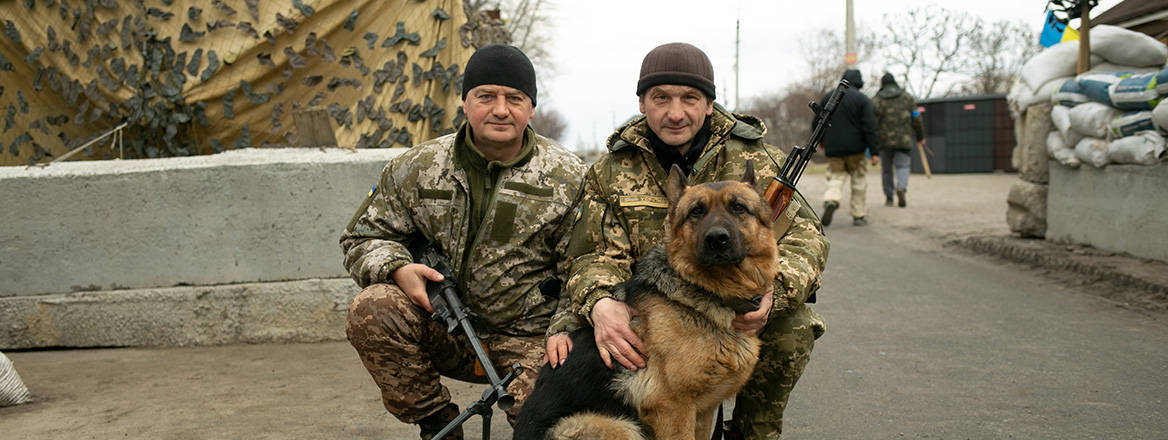Ukraine’s Territorial Defence Forces: The War So Far and Future Prospects
Since the beginning of the full-scale invasion, the Territorial Defence Forces have played a crucial role in thwarting Russian plans. But what does the future hold for these determined fighters?
The revamped Territorial Defence Forces (TDF) of Ukraine, as a separate branch of the Armed Forces of Ukraine, function in accordance with the law ‘On fundamentals of national resistance’ enacted in July 2021. This law envisioned that the TDF might be engaged in both specific rear area protection functions and ‘timely response [actions] while taking measures to defend territories and populace at certain locations’, which allows for quite a broad interpretation. The TDF military component consists of TDF Command, regional headquarters and brigades/battalions for each region/district. Estimates produced prior to 24 February 2022 suggested the TDF would be able to engage as many as 130,000 people (25 brigades of 150 battalions) in mass national resistance in the case of all-out war with Russia.
In practice, the implementation of the law’s provisions related to the TDF coincided with the last stages of Russian strategic deployment in January–February 2022. In this short time, it was possible to nominally establish command nuclei for brigades and battalions in border regions, regional headquarters and a central TDF Command. It was stipulated that contract servicemen would form a command nucleus numbering 10,000 troops, which would be enlarged with trained reservists in the case of war. Pre-24 February 2022 plans envisioned that manning the TDF with reservists would take place until the end of June 2022 with a parallel training process. Other organisational issues were addressed in January–February 2022, including the establishment of a command-and-control vertical, acquisition of bases, and establishment of armouries.
On 24 February 2022, the TDF was in the process of completing the first stage of organisational developments: creating a professional peacetime nucleus. There were difficulties in the acquisition of bases and as a result the establishment of armouries. Even the professional peacetime nucleus of the TDF was not provided with the proper amount of communications equipment, means of individual protection or automobiles. This is why the TDF was still in the process of attaining initial combat readiness status for wartime. At the same time, there was a nominal legal and organisational framework based on the law ‘On fundamentals of national resistance’, which could be used in the case of all-out war to quickly engage more than 100,000 people for all-out national resistance.
The TDF’s Experience of High-Intensity War with Russia
As Russia launched its full-scale invasion of Ukraine on 24 February 2022, the TDF proved instrumental in foiling the initial Russian plan. Ukraine’s political-military leadership simplified the process of joining the TDF – citizens only needed to present ID cards to join its ranks. This allowed the TDF to recruit around 50,000 Ukrainians by the end of 26 February 2022. By May 2022, approximately 110,000 individuals had joined the TDF. Additionally, around 70,000 Ukrainians were part of 700 voluntary territorial formations provided for by the law ‘On fundamentals of national resistance’ as a civil-military component of the territorial defence system. In general, the first TDF units were able to join the resistance in 3-4 hours after the beginning of all-out war.
The deployment of the TDF in the first month of all-out war made it possible to implement mass national resistance and inflict maximum losses of men/equipment on the enemy
From the outset, the TDF performed the whole spectrum of functions prescribed by law. But while rear region brigades and battalions executed mostly law-and-order functions, border region TDF formations were engaged in high-intensity warfare complementing other formations of the Ukrainian Defence Forces in the battles for the Kyiv, Chernihiv, Kharkiv, Mariupol, Sumy, Luhansk, Donetsk, Zaporizhzhia and Mykolayiv regions. TDF engagement prevented the quick isolation and reduction of Ukrainian resistance in major urban areas. Resistance consisting of the 54th separate reconnaissance battalion and the TDF prevented Russia from occupying such important railway stations as Nizhin and Pryluky in the Chernihiv region. The TDF formed the core of resistance in Sumy, and swelled the numbers of defending forces in Chernihiv, Kharkiv, Kyiv and Mariupol. The Zaporizhzhia region TDF was forced to perform rear-guard action after the Russian breakout from Crimea. As the invasion unfolded, TDF units were engaged in intelligence collection, combatting enemy sabotage attempts, and the destruction of logistics columns and deserted heavy equipment. Isolated TDF resistance in some Ukrainian urban areas forced Russia to divert resources necessary for further advances. The deployment of the TDF in the first month of all-out war made it possible to implement mass national resistance and inflict maximum losses of men/equipment on the enemy from the very beginning, as prescribed in the TDF Doctrine of January 2022.
From mid-April 2022, the deployment of the TDF was affected by a number of changes in Russian and Ukrainian tactics as the epicentre of the fighting shifted to Eastern Ukraine. Russia switched to a strategy of artillery-supported advances instead of trying to overwhelm Ukrainian positions with armour moving on major roads. The fighting became more non-contact in character, with artillery duels being the decisive factor instead of the emphasis on contact warfare seen in the first month of the invasion. Under these conditions, it was more difficult for TDF formations – armed at best with anti-tank guided missiles (ATGMs) and grenade launchers – to effectively confront Russian forces. At the same time, Ukrainian forces switched to using static defences, with defence-in-depth and continuous frontlines. To perform tasks within this approach, TDF brigades and battalions were deployed out of the regions/districts where they were formed, which was envisioned by legislation.
Warfighting under such conditions proved to be a challenge for the TDF. There were instances where TDF formations had to abandon their positions, unable to withstand Russian artillery advances – although withstanding these tactics proved to be a problem for more heavy Ukrainian formations too. At the same time, TDF forces aided in relieving more heavy formations by performing heavy fighting in priority areas. Moreover, the TDF assumed the main responsibility for border protection after Russian forces left Northern Ukraine in early April 2022 and were expelled from the Kharkiv region in September 2022. In addition, the performance of TDF brigades such as the 110th (Zaporizhzhia region) proved to be quite impressive given the conditions they faced.
Assessment of the TDF Experience
The experience gained by the TDF after 24 February 2022 has demonstrated a number of problems and weak points that were a direct result of having insufficient time to implement all the measures needed to reach full operational capability status, rather than the TDF concept in general. Basic training of reservists was carried out in parallel with raising the TDF to wartime strength; very often, training took place on ranges belonging to other branches of the Armed Forces. Real warfighting has demonstrated the need for TDF servicemen to be familiar with a wider range of weaponry in order to effectively perform combat functions. On 24 February 2022, the TDF had an acute deficit of communications equipment, means of individual protection and vehicles. As a result, interoperability with other formations was negatively affected. The weaponry of the TDF envisioned by legislation (air defence systems, artillery, Soviet ATGMs, recoilless rifles, 60 mm mortars) was missing. Despite having nominal command components, not all TDF officers demonstrated the level of command proficiency necessary to plan and conduct operations or organise training processes.
Mass decentralised resistance is as important a factor in this conflict as technological superiority, which for Ukraine will be very difficult to achieve
But despite all the initial deficiencies and problems, TDF Command demonstrated a readiness for adjustments. Training was organised using private properties on a partnership basis. A separate mobile training centre was organised by TDF Command. A ‘School of Captains’ was established to improve the proficiency of commanders at platoon, company and battalion level. Private donations (including from the organisation ‘Come Back Alive’) helped to remedy the situation with basic equipment.
The Future of the TDF
The TDF’s role in the future model of the Ukrainian defence sector is debated behind closed doors. There are those who would like to repeat the move implemented after 2015, when the territorial defence battalions were transformed into four motorised battalions, which later joined the new motorised brigades of the Land Forces. However, such a scenario carries the risk that these brigades would be marginalised in terms of capacity building and training. There are also suggestions of bringing the TDF back under the Land Forces command structure where it was before 2022 and financing/manning it on residual principle.
But it would be more reasonable to preserve the TDF as a separate branch directly subordinated to the Armed Forces Commander in Chief, with a two-tier manning structure (cadre command nuclei and reservists) and concentrating on improvements in doctrine, training, equipment, leadership and interoperability.
Events subsequent to 24 February 2022 proved the soundness of the TDF model based on the law ‘On fundamentals of national resistance’. This model holds the promise of quickly engaging up to 200,000 people in mass national resistance. Mass decentralised resistance is as important a factor as technological superiority, which for Ukraine will be very difficult to achieve. A two-tier manning structure will ensure that reservists undergo a necessary basic training regime of 120 hours a year without being disengaged from active economic life. Moreover, the TDF might be a basis for universal training of Ukrainian citizens as a preparation for national resistance. In sum, the current TDF model, if more thoroughly implemented, could produce significant results from a standpoint of ‘invested funds – gained outcomes’ and along with other measures will form a strong basis for non-nuclear deterrence.
The views expressed in this Commentary are the author’s, and do not represent those of RUSI or any other institution.
Have an idea for a Commentary you’d like to write for us? Send a short pitch to commentaries@rusi.org and we’ll get back to you if it fits into our research interests. Full guidelines for contributors can be found here.
WRITTEN BY
Mykola Bielieskov
- Jim McLeanMedia Relations Manager+44 (0)7917 373 069JimMc@rusi.org


